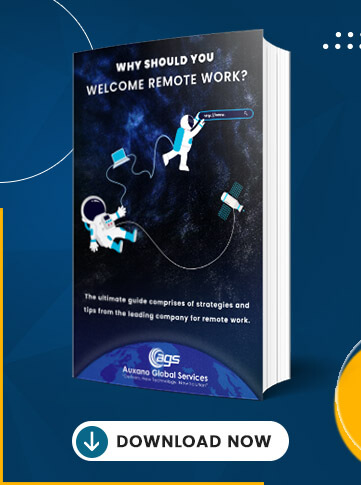The gaming industry is growing manifold, and the demand for casual game development services is also rising steadily. Casual games are among the most popular mobile and desktop gaming genres as they provide users with an entertaining and interactive experience.
Several companies are planning to capitalize on the potential of this genre and are looking for game development services to create a successful casual game. But the cost of developing a casual game varies significantly depending on various factors.
This article will cover the different elements and costs associated with developing a casual game. Before we dive deeper into casual gaming, let’s first look at some statistics.
Statistics
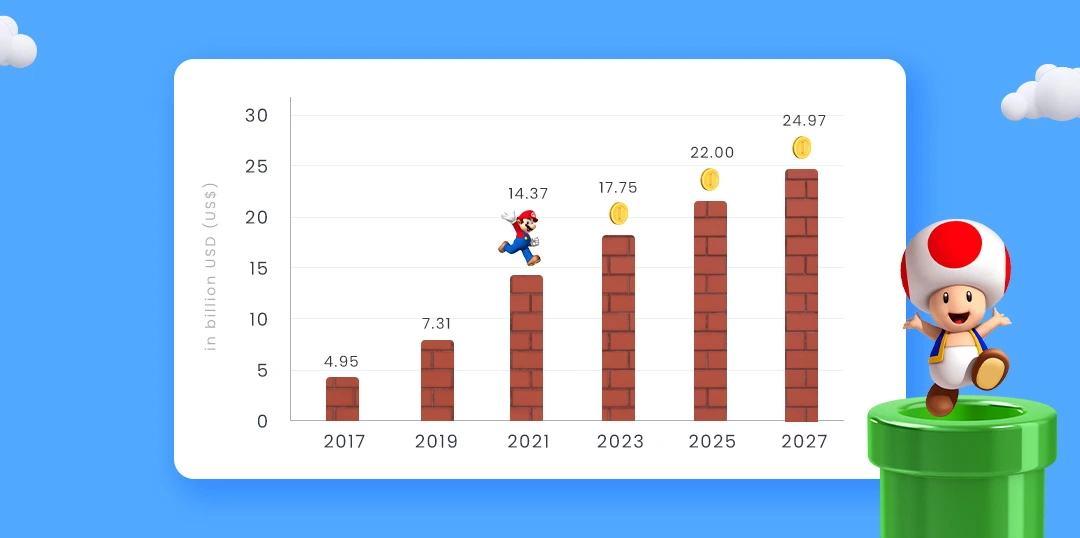
1. According to reports, the casual gaming revenue was around $15.51 billion in 2022, and it’s expected to touch the mark of $24.97 bn by 2027. Moreover, the average revenue generated per download is around $0.85.
2. According to Google’s report, around 63% of users play casual games to pass the time, and they play the games frequently.
3. According to reports, in 2022, there were around 90 billion downloads for mobile-based gaming apps, out of which hyper-casual and casual games were the main drivers of the downloads.
Looking at the statistics, it’s clear that developing casual games can be a profitable business. Now let’s look at the benefits of developing casual games for users.
Benefits of Developing a Casual Game
Before you opt for game development services, it’s essential to consider the benefits that a casual game can offer.

1. Low Barrier of Entry
Casual games require minimal resources to develop, and they can be played in short bursts. This makes them perfect for users who are looking for quick entertainment without having to invest substantial amounts of time. In addition, they can be easily developed and released quickly.
2. Cross-platform
Most casual games are optimized for mobile, desktop, and console platforms. This means you can reach a larger audience across multiple platforms. Moreover, casual games are incredibly engaging and offer players an immersive experience. Once users start playing a casual game, they are likely to keep coming back for more.
3. High Replay Value
Casual games, if designed correctly, have high replay values. This makes them attractive to users who want to play a game without having to put in too much effort. Moreover, casual games can also be updated regularly, making them even more attractive to users.
Now that you know the benefits of developing a casual game, let’s look at the process of developing a casual game.
How to Develop a Casual Game?
Casual mobile game development involves creating simple games to enjoy in short bursts. Let’s break down each step of the development process to ensure your game is a success.
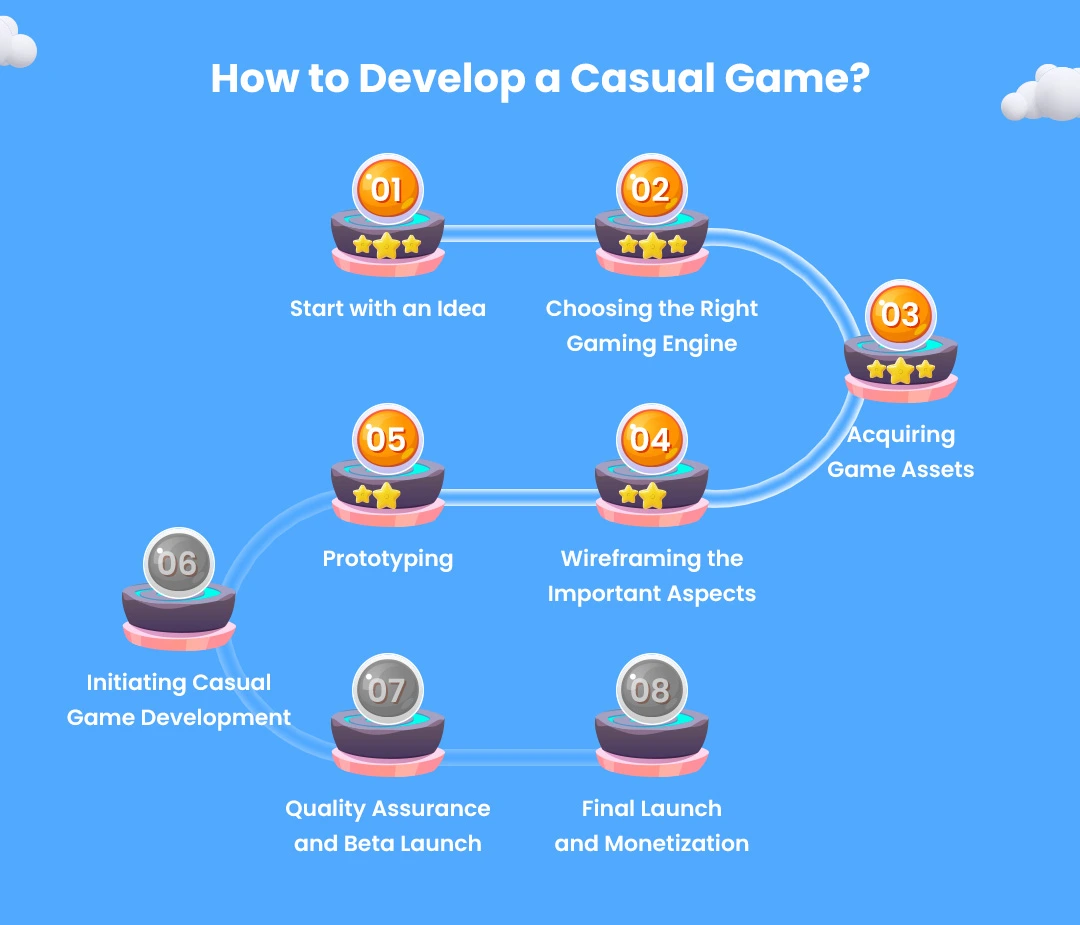
1. Start with an Idea
To create the perfect casual game, you’ll first need a great idea. Consider the type of game you want to create, who your target audience is, and what features will make it stand out from the crowd. Furthermore, think about the type of game mechanics you can incorporate. Start by brainstorming concepts that are achievable within your budget and timeframe.
Before you start development, it’s important to research your target audience and competition. Analyze the games that are currently popular in the market and identify what makes them successful. Research what your target audience likes and include this feedback in the design of your game.
2. Choosing the Right Gaming Engine
Which casual game developers to hire will depend on the type of game you’re creating. Although there are many different game engines available, it’s important that you select one that works best for your project and budget. For instance, Unity is fabulous for 3D games, while Cocos2d-x is better suited for 2D projects.
Furthermore, the gaming engine you select should be compatible with the device platforms that your players use. A good option is to create a responsive game, meaning it will adapt to the device type and dimensions. It’s crucial to make sure that your game is compatible with a range of devices, including iOS and Android.
3. Acquiring Game Assets
Once you’ve got the basics down, it’s time to focus on acquiring game assets. You can buy premade 3D models and art assets from various websites or create your own with a graphic design program. When selecting music and sound effects, make sure they are free of copyright laws and fit the theme of your game.
While it’s tempting to skimp on this step, remember that good game assets can make or break your project. If you’re tight for time and money, consider using royalty-free assets, or you could opt to outsource the work. It’s a good way to save time and money, but make sure that the provider you select is reputable.
4. Wireframing the Important Aspects
Before you start building the game, it’s essential to create a design document. This is basically a blueprint that outlines all of the key aspects and goals for your casual game project. In this document, you will need to include a wireframe of the different game screens, such as menus, levels, and options.
Doing so will help ensure that everything is accounted for and goes smoothly when the game is being developed. Furthermore, it’s a great way to ensure that all of the features are properly implemented, leading to a better user experience.
5. Prototyping
Prototyping is the process of testing and refining your game before it’s launched. During this phase, you can identify any potential issues or bugs that need fixing. It’s also a great way to receive player feedback so you can make changes if needed. You can use tools such as Unity or Unreal Engine to test different gameplay mechanics before launching the game.
While prototyping, it’s crucial to ensure that the game development process is in line with your original concept. With this approach, you can be sure that the finished product looks and functions as expected.
6. Initiating Casual Game Development
Now comes the main part – creating the actual gameplay. This is where you decide how the game mechanics will work and what objectives players must achieve. Start by writing down the gameplay rules and setting up the different levels. As you move forward, test out each feature to make sure that it works properly.
Finally, remember to incorporate elements of fun and challenge into your casual game. This could include time-limited challenges, puzzles, or mini-games. By adding these elements, you can create an engaging game that keeps players coming back for more.
7. Quality Assurance and Beta Launch
The next step in the game development process is quality assurance (QA). This involves testing the game for any bugs or glitches and making sure that it meets industry standards for performance and user experience. You can use automated software to help with this step, or you can hire testers to check each feature manually.
Once all of the tests have been completed, it’s time for the beta launch. This is basically a trial run of the game before its official launch. During this phase, you can get valuable feedback from players and make any necessary changes.
8. Final Launch and Monetization
Finally, you’re ready to launch your bespoke casual game. You can launch your game on app stores such as the Apple App Store and Google Play to distribute the game. You can also opt for a free-to-play model or offer the game as a paid download.
Whichever approach you choose, make sure that you have a plan in place to monetize the game. This could include in-app purchases, adverts, or even selling custom merchandise. With a solid monetization plan in place, you can maximize your return on investment and generate more revenue from the game.
Now, let’s explore how much time you need to invest in developing a casual game so that you can start making a profit.
How Long Does It Take to Build a Casual Game?
On average, it takes around 6 to 8 months to build a casual game. The time taken to develop the game depends on the below factors that you need to take into consideration:
1. The complexity of the gameplay: If you select to create a casual game with an intricate design and sophisticated programming, it takes much longer to develop.
2. The size of the team: You need to decide how many people will work on the game. If the development team comprises experienced professionals, it will take less time but may cost more.
3. The technology used: The latest technologies and tools can speed up the process. You need to select the programming language and game engine in accordance with the complexity of your game.
4. The platform: Depending on the platform (iOS or Android) you decide to launch your game on, the development time will vary.
On this note, let’s explore the factors affecting the cost of casual game development solutions so that you can better gauge the timeline and budget.
Factors Affecting the Cost of Creating a Casual Game
Every game is unique, so the development costs may vary widely. Factors such as complexity, size of the development team, technology, and platform used can affect the cost of creating a casual game.
Here’s a look into some of the crucial factors for a casual game:
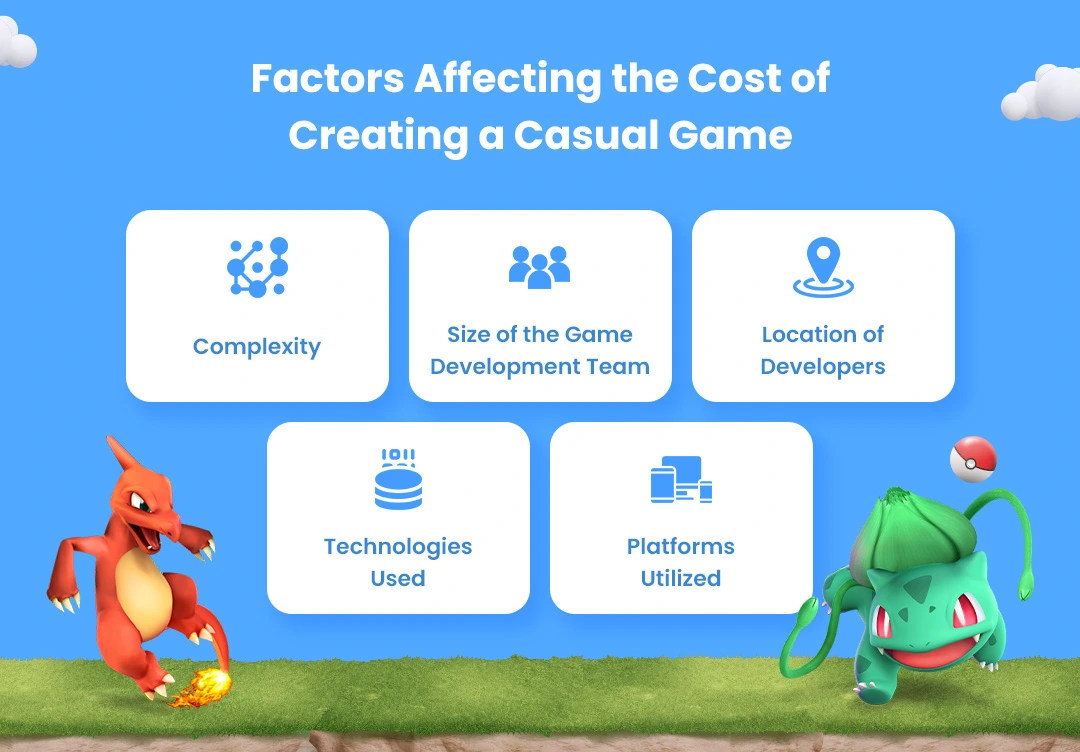
1. Complexity
The more complex the gameplay features and design, the more expensive it will be. Complex games may require more intricate programming and graphics resources, which means a larger development team and a longer timeline.
The complexity of the game can also affect how long it will take to complete. Complexity can range from simple puzzles to 3D games with multiplayer capabilities and intricate levels. Furthermore, games that require more levels, javelins, and other features will take longer to develop.
2. Size of the Game Development Team
The size and expertise of the game development team can also have a significant impact on cost and timeline. If a game requires complex features, the developer will need to bring on more specialists, such as graphic designers, animators, sound engineers, and so on. A larger team also means more overhead costs, such as salaries and equipment.
When you hire dedicated game developers, it’s important to make sure they have the skills and experience needed for the game you’re looking to create. You first need to analyze how many developers you need and then decide on a budget.
3. Location of Developers
Depending on where the game developers are located, it can also affect the cost of creating a casual game. Developers in certain regions may have different skill sets and varying labor costs. If you’re outsourcing your game development team, make sure to research the expected labor costs for each region before deciding who to hire.
For example, developers in the United States are likely to cost more than those from countries like India or China. Furthermore, outsourcing development can be an excellent option if you’re working with a limited budget.
4. Technologies Used
The type of technology used can also affect the timeline and cost of casual game development. Some technologies are more complex and require more programming hours, while others may be simpler but cost more for licensing.
It’s important to research the technologies that can best assist your game and find a balance between complexity and cost. For example, if you’re working on a 2D puzzle game, consider looking into middleware like Unity or Unreal Engine.
5. Platforms Utilized
The platforms you plan to release your game on can also affect the cost and timeline of development. Some platforms may require additional resources, such as porting or special features that need to be implemented before your game is ready for release.
This can add extra time and cost, so it’s important to consider how many platforms you want to release your game on before you begin development.
After knowing the affecting factors casual game development, let’s explore how much it costs to create a casual game.
How Much Does It Cost To Build a Casual Game?
The cost for Casual mobile game development solutions will vary based on the above factors that we have discussed. Generally, the cost of developing an MVP casual game can range anywhere from $25k to $55k. In order to create a casual game with advanced features & functionality, you may need to spend between $55,000 to $1,20,000 or more.
The costing factor can also be estimated based on the amount of time it takes to develop a game. As mentioned earlier, the exact timeline will depend on the complexity of the game and the size of the development team.

Before you hire a game development company to execute your idea, let’s look at some of the effective and value-driven ways to optimize the overall cost.
Bonus Point: Strategies for Reducing Casual Game Development Cost
Mobile game development comes at a cost, and oftentimes, the cost of casual game development is higher. However, there are strategies that can be applied to reduce these costs and make the development process more efficient.
Let’s look at some of the strategies that can be used to reduce the cost of casual game development.
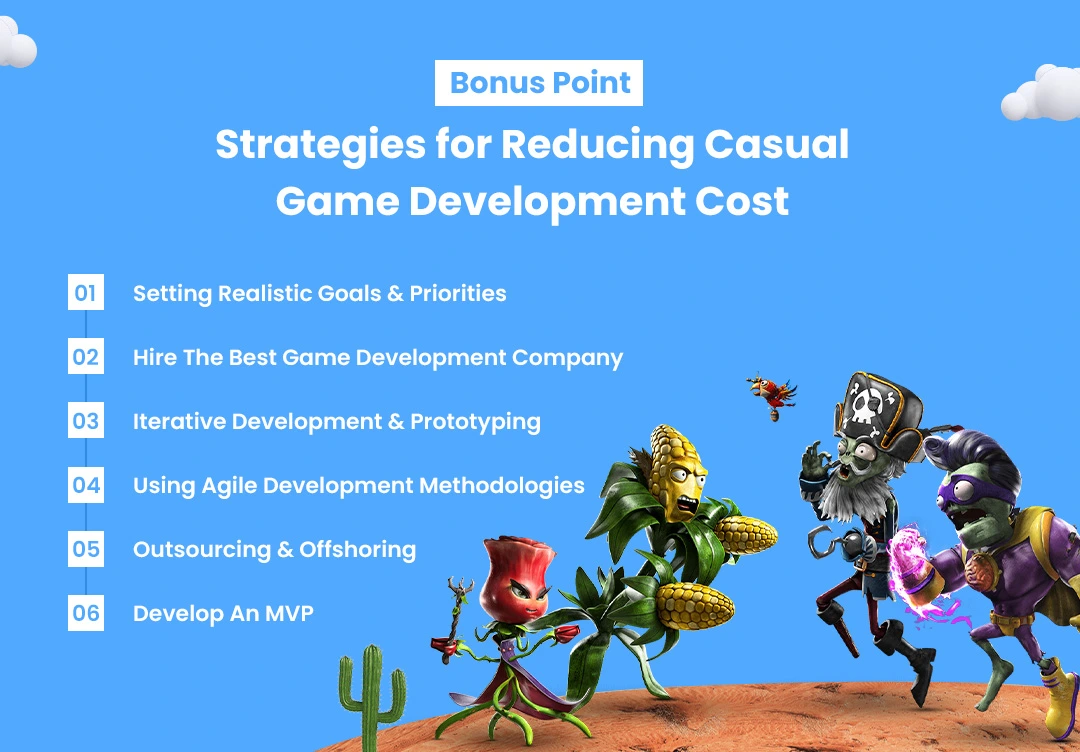
1. Setting Realistic Goals & Priorities
Setting realistic goals and priorities can help limit the scope of game development. It is important to understand what features are absolutely necessary and which ones can be sacrificed. This will enable developers to focus their efforts on the key elements that make up a successful game while also reducing development costs.
To set realistic goals, you first need to perform market research and gain an understanding of the target audience for the game. This will help you determine which features are a must-have, which can be skipped, and which ones should be prioritized. When your team progresses with the goals and priorities in mind, it will help save time and money.
2. Hire The Best Game Development Company
When you hire a casual game development team from the best game development companies, you can ensure that you get the most out of your resources. Experienced developers will be able to optimize their workflow and leverage every opportunity to make the game development process more efficient.
In addition, when you hire a team from the best game development company, you also get access to the latest technologies, which can help you reduce development costs. It becomes easier for you to stay on top of trends and take advantage of new technologies.
3. Iterative Development & Prototyping
Iterative development and prototyping are key tools in reducing the cost of game development. By breaking down the development process into small, manageable chunks, developers can identify issues early on and fix them before they become major problems. This reduces costs by ensuring that fewer resources go towards fixing errors that could have been avoided.
In addition, iteration allows developers to try out new ideas and techniques, which can lead to unexpected innovations. For example, by testing various game mechanics and trying out different level designs, developers can come up with a more interesting product that stands out from the competition.
4. Using Agile Development Methodologies
Agile development methodologies refer to the process of delivering features in a series of iterations. By following an agile approach, developers can continuously deliver new updates and tweaks to the game. This enables them to stay ahead of the competition while reducing costs by avoiding unnecessary rework.
In addition, using agile development methodologies allows developers to respond quickly to changes in the market and customer feedback. This helps them build a better product that caters to their target audience while also reducing development costs. With higher agility, developers can easily add new features and make improvements without having to start the development process all over again.
5. Outsourcing & Offshoring
While searching for casual game developers for hire, companies can benefit from outsourcing or offshoring their development needs. This is especially helpful if the development team has limited resources available. Outsourcing and offshoring will help companies access high-quality talent in a cost-effective manner while also reducing development costs.
In addition, by working with developers located in other countries, companies can benefit from tax incentives and other cost savings. It is also important to keep in mind that outsourcing and offshoring can help companies tap into new markets, which can be beneficial in terms of revenue. Furthermore, it can also help companies access new technologies and gain a competitive edge in the market.
6. Develop An MVP
Finally, to reduce development costs and minimize risks, it is important to develop an MVP (Minimum Viable Product). An MVP helps developers identify key features that should be included in the game.
It also helps them focus on the most important aspects of the game, which saves time and money. For developing an MVP and further iterations, it’s important to hire an experienced MVP development company like AGS to gain an edge.
Why Choose Auxano Global Services for Casual Game Development?
AGS is an innovative casual game development company that uses the latest technologies and tools to create visually stunning, engaging games. With an experienced team of developers, AGS can deliver high-quality casual games on time and within budget.
Additionally, AGS is well-versed in all the latest development trends, from virtual reality to augmented reality. This ensures that companies can stay ahead of the competition and develop more immersive games for their customers. Connect with us and start your casual game development journey today!
Wrapping up!
Developing a casual game can be a complex and costly process. However, by taking the right approach, companies can reduce development costs and create an engaging, enjoyable game. By breaking up development into small chunks, following an agile methodology, outsourcing, and offshoring work, and developing an MVP, companies can create a high-quality product in an efficient manner.
Frequently Asked Questions
-
1. How much does it cost to develop a casual game?
The cost of developing an MVP casual game usually ranges from $25k to $55k. If you want to create a casual game with advanced features and functionality, you may have to spend between $55,000 to $1,20,000. Feel free to contact us if you would like to receive an estimate based on your needs.
-
2. Why are casual games so popular among mobile gamers?
Casual games are popular among mobile gamers due to their easy-to-learn nature, short playtime, and engaging content. This makes them a great way to fill small moments throughout the day.
-
3. How much time is required to develop a casual game?
The amount of time required to develop a casual game can range from 6 to 8 months, depending on the complexity of the game. With an experienced team and a clear strategy, developers can create high-quality games in a timely manner.
-
4. What makes casual games different from other types of games?
Casual games are more focused on simplicity, easy-to-learn gameplay, and attractive visuals. They don’t require a lot of time to play, making them ideal for short bursts throughout the day. All these factors make casual games different from other types of games.
-
5. What factors affect the cost of developing a casual game?
The cost of developing a casual game depends on many factors, such as the complexity of the game, the size of the development team, and the type of technology used.





![How the Internet of Things Impacts the Game Industry? [2023]](https://www.auxanoglobalservices.com/agsresources/wp-content/uploads/2023/04/How-the-Internet-of-Things-Impacts-the-Game-Industry.jpg)
